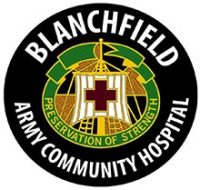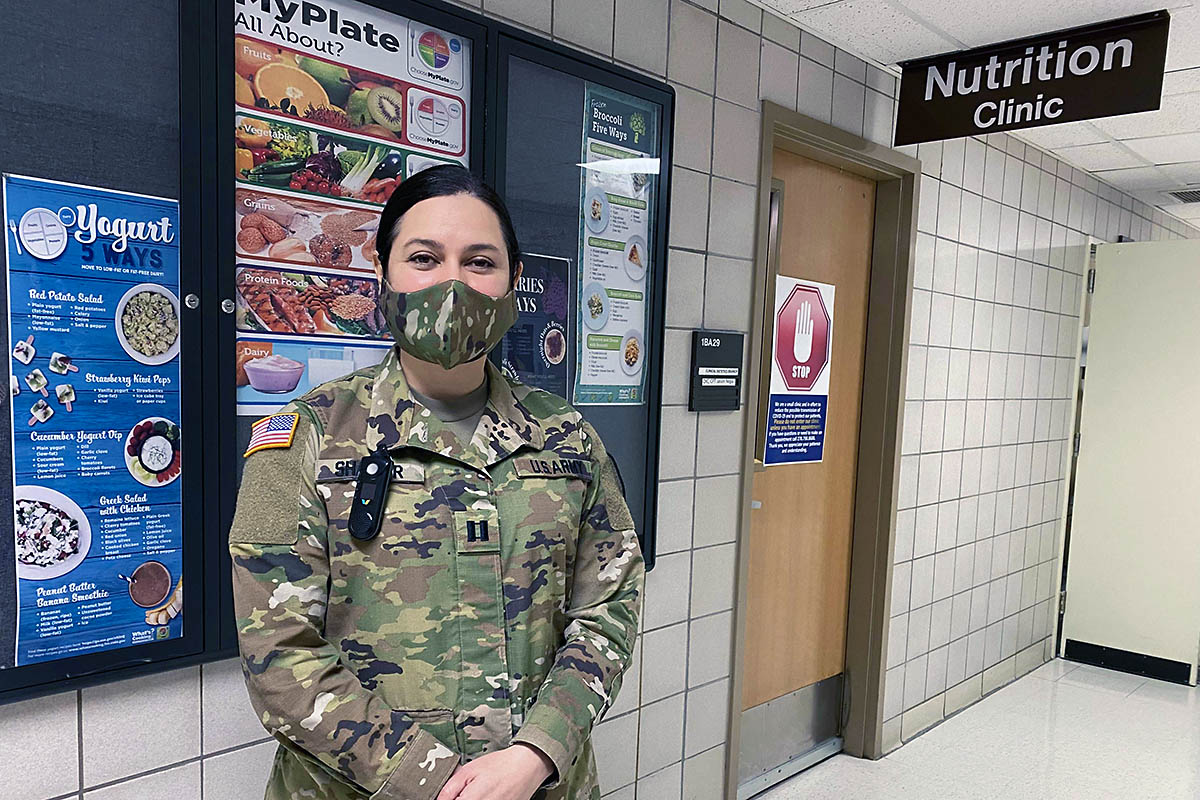Blanchfield Army Community Hospital Public Affairs
 Fort Campbell, KY – She doesn’t swab nasal cavities to test for COVID-19 Coronavirus or administer COVID-19 vaccines to military healthcare beneficiaries, but one Army dietitian in the fight shared her experience contributing to the COVID-19 Coronavirus response mission.
Fort Campbell, KY – She doesn’t swab nasal cavities to test for COVID-19 Coronavirus or administer COVID-19 vaccines to military healthcare beneficiaries, but one Army dietitian in the fight shared her experience contributing to the COVID-19 Coronavirus response mission.
Capt. Melissa Shaffer, a registered dietitian-nutritionist at Blanchfield Army Community Hospital (BACH) oversees the nutritional needs and special diets of all patients admitted to the hospital.

Shaffer is also a Certified Nutrition Support Clinician, specifically trained to work with critically ill patients and was part of the hospital treatment team for a critically ill COVID-19 Coronavirus patient.
Air Force retiree Mr. Gino Garcia spent about two months in Blanchfield’s intensive care unit where a team of healthcare professionals worked together to help him recover from the deadly virus.
“The last thing I remember was that I had COVID and that I went through [the hospital] doors to be taken care of like any other patient. After that I don’t have any other memories,” said Mr. Garcia.
When he first arrived, his doctors noticed he wasn’t able to oxygenate his blood so they decided he would benefit from being intubated and placed on a ventilator.
A ventilator is a life-support machine that uses a tube inserted into the trachea through the mouth or nose that forces air into the lungs, artificially breathing for a patient who cannot adequately breathe on their own. Ventilated patients cannot swallow or talk and may be sedated.
Now in recovery, Garcia referred to his time on the ventilator as “lights out” because he had no recollection of the month prior when the ventilator, his care team, his family’s love, and many prayers were at work to help him beat COVID-19 Coronavirus.
Shaffer was responsible for the nutrition care needs of Mr. Garcia, which she coordinated with other medical specialists involved with his care.
“Nutrition plays an important role with the recovery of critically ill patients. Since Mr. Garcia was ventilated and sedated he couldn’t eat on his own,” said Shaffer. “You have to feed critically ill patients who are ventilated with enteral tube-feeding and you have to consider the formula, the rate, and the type of feeding you are going to give them.”
Shaffer used predictive equations to calculate his energy needs and started Mr. Garcia out on a continuous feed of a no fiber, high protein formula to meet all of his nutrition needs. She gave him additional protein supplements so he wouldn’t lose a lot of lean body mass while he was hospitalized and also evaluated his medications.
“We screen all the patient’s medication for nutrient/drug interactions. There are certain things you have to watch for if somebody is on tube feedings because certain drugs can deteriorate the tube,” she said.
Each morning Shaffer would attend the morning report with other members of Mr. Garcia’s treatment team. It included doctors, respiratory therapists, intensivists, social workers, clinical pharmacists, and physical and occupational therapists among others who each contributed their specialized knowledge to Mr. Garcia’s treatment. The nurses responsible for his care would brief his condition and any changes since the day before.
“I’m interested in things like how the feeding tube is working, is the patient tolerating the feeding, the patient’s bowel movements because you want to make sure everything is moving properly,” said Shaffer.
Garcia’s case was extremely critical but after nearly a month on the ventilator, he began to improve and became aware of his surroundings.
He was very weak from the toll the virus took on his body but ready to begin the recovery process with the help of his family and care team.
Shaffer was responsible for making sure he had the nourishment to aid his recovery which presented some challenges.
“After such a long time in that position, I forgot about eating. I forgot the taste of food, color, and aroma. So I had to kind of rearrange my brain…and go through the learning process like a baby learning to eat,” Garcia said.
Shaffer explained that when a ventilator tube is removed some people may have issues with eating, and swallowing. Patients sometimes have to relearn those skills and with ventilation, they are not using their muscles so they may lose muscle strength.
Once he was able to breathe on his own Garcia’s ventilator feeding tube was replaced with a thinner feeding tube through his nose. This tube would allow him to begin the process of learning to eat and feed himself again. Shaffer continued tube feeds to meet his energy needs until he was able to meet them through eating on his own.
The treatment team used a multi-disciplinary approach for Mr. Garcia’s nutrition and self-feeding rehabilitation.
A speech pathologist performed a swallow evaluation to determine the texture of foods that Mr. Garcia could tolerate and provided the information to Shaffer so her team in nutrition care could create foods he could consume. Shaffer did daily calorie counts to assess how much Mr. Garcia was eating by mouth. As that improved, she began taking him off tube feeds and protein supplements.
He started with thickened liquids and after his first swallow study, he was able to have pureed foods and mechanically softened foods like applesauce, as well as puddings and gelatin.
“A lot of times a patient will want a specific food but you have to change the texture of it, so our patient food service team would blenderize or modify it to get it to the right texture,” Shaffer said. Once Mr. Garcia progressed to scrambled eggs and grounded meat with gravy he no longer required tube feedings.
Meanwhile, the hospital’s occupational therapy and physical therapy personnel also played a large part in helping Mr. Garcia regain his self-feeding skills.
“Many times it was like turmoil because you would expect that I could [feed myself] very easy, but it wasn’t. I didn’t have the strength in my hands. I didn’t have the balance in my hands,” said Garcia.
Little by little Mr. Garcia was able to grasp onto the spoon, hold a fork, and became confident grabbing a cup.
“He was a very strong guy and he worked very hard because he didn’t want to be on tube feeds anymore. He wanted to eat by mouth,” said Shaffer.
After several weeks from coming off the ventilator, Mr. Garcia was healthy enough to transition to a rehabilitation facility where he continued his regain strength and the daily living skills he had before contracting COVID-19 Coronavirus.“Our whole team was rooting for him and his recovery. So it feels great to know he’s improving and that we played a part in it,” said Shaffer. “I am so incredibly proud of him.”
In the Army, the field of nutrition is vast and Army RDs can do a number of different jobs, from clinical to food production and humanitarian missions. Army dietitians also work closely with Army physical therapists through the Army’s Holistic Health and Fitness Program to help educate Soldiers on performance nutrition to meet the physical demands of field training and combat.
Army dietitians have at least a bachelor’s degree in nutrition, dietetics, or institution management from an accredited institution, completed a dietetic internship, and be a registered dietitian through the Commission on Dietetic Registration.



